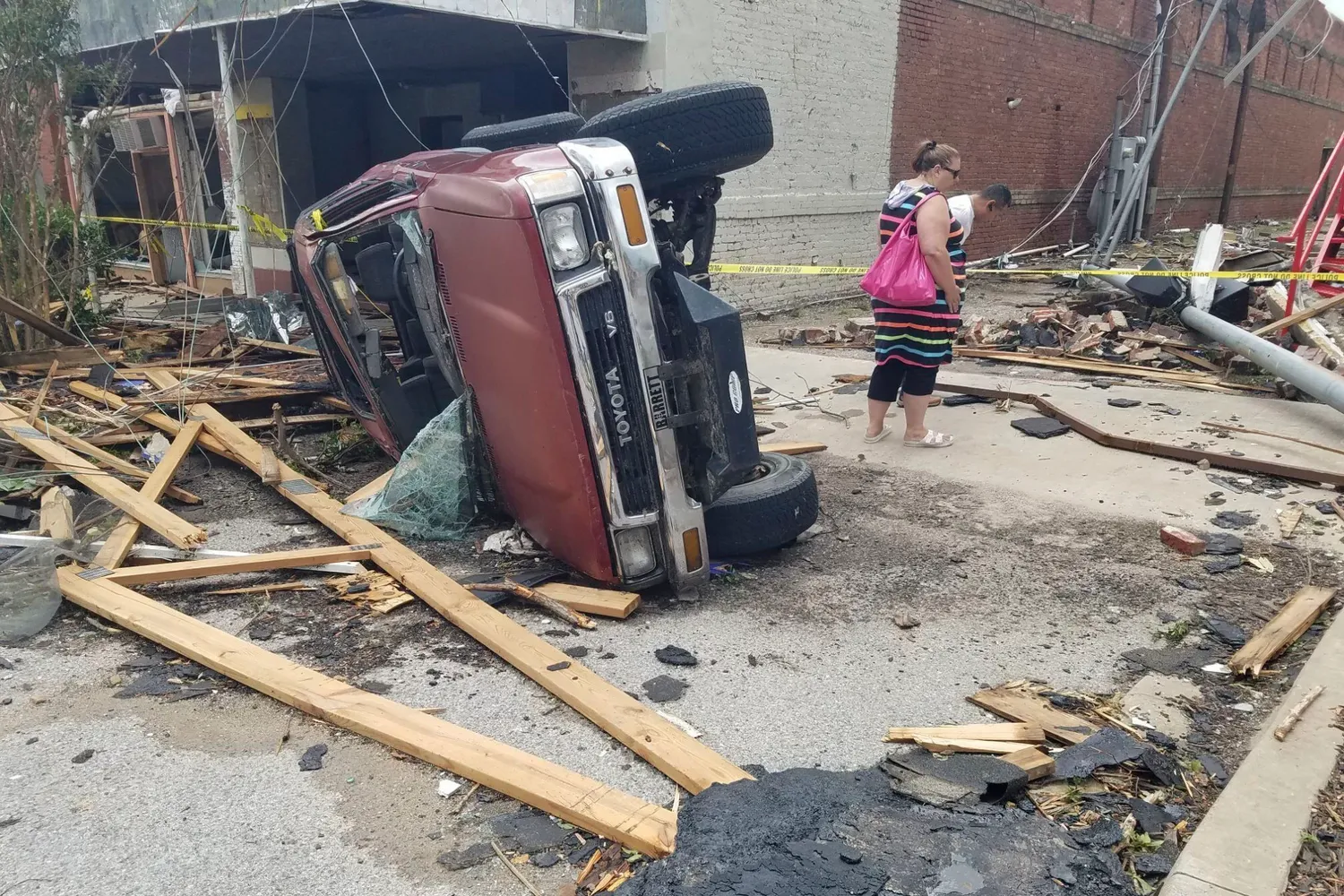Natural Disaster
Tornadoes kill 4 in Oklahoma, leaving trail of destruction
In a devastating turn of events, a series of tornadoes swept through Oklahoma, leaving a trail of destruction, claiming at least four lives, and rendering thousands without power. The severe weather outbreak began late Saturday night and continued into the early hours, with emergency services working tirelessly to respond to the aftermath.
The tornadoes, part of a larger weather system that included high winds, hail, and flooding, have affected a significant portion of the nation's midsection since Friday. As of Sunday, flood watches and warnings were in effect not only for Oklahoma but also for neighboring states, including Kansas, Missouri, Arkansas, and Texas.
The small town of Holdenville, with a population of approximately 5,000, was among the hardest hit. At least two individuals, including a child, lost their lives in this community. The tornado struck late in the evening, injuring four others. The Oklahoma Office of the Chief Medical Examiner confirmed additional fatalities, including one on Interstate 35 near Marietta and another in Sulphur. The Oklahoma Department of Emergency Management reported at least 100 injuries throughout the state, with the nature of injuries ranging from falls and cuts to transportation-related incidents.
Governor Kevin Stitt expressed his condolences to the families of the deceased and issued a statement, "My prayers are with those who lost loved ones as tornadoes swept through Oklahoma last night." In response to the storm's aftermath, Stitt declared a state of emergency in twelve counties, directing emergency crews to clear debris and assess damages from the severe weather that had brought down power lines. As of Sunday morning, nearly 33,000 customers in Oklahoma and nearly 67,000 customers in Texas were left without power, according to poweroutage.us.
The southern Oklahoma communities of Sulphur and Marietta reported significant damage, with a hospital in Marietta sustaining damage. The storm's fury extended beyond Oklahoma's borders, leaving a path of destruction in its wake. In suburban Omaha, Nebraska, a tornado demolished homes and businesses Saturday, moving for miles through farmland and into subdivisions. Dr. Lindsay Huse, health director of Douglas County Health Department, reported that fewer than two dozen people were treated at Omaha-area hospitals, with no serious injuries reported.
The tornado damage began on Friday afternoon near Lincoln, Nebraska, where an industrial building was struck, causing it to collapse with 70 people inside. Although several individuals were trapped, all were safely evacuated, and the injuries sustained were not life-threatening. Chris Franks, a meteorologist with the National Weather Service's Omaha office, estimated that one or possibly two tornadoes had spent around an hour approaching Omaha, leaving behind damage consistent with an EF3 twister, with winds of 135 to 165 mph.
Governors Jim Pillen of Nebraska and Kim Reynolds of Iowa spent Saturday touring the damage and coordinating assistance for the affected communities. Formal damage assessments are still underway, with both states planning to seek federal aid.
The tornadoes that began on Friday and continued through the weekend are part of a broader pattern of severe weather that has affected the Central United States. The National Weather Service had issued multiple tornado warnings throughout the weekend as the storms moved through the region. The severe weather threat is expected to continue, with the National Oceanic and Atmospheric Administration's Storm Prediction Center issuing a Level 3 (out of 5) risk of severe weather for the ongoing stretch of severe storms traveling eastward toward parts of Texas, Louisiana, and Arkansas. A Level 2 risk was issued for other parts of Texas and Missouri.
The aftermath of the tornadoes has left extensive damage in several counties, with local authorities reporting power outages, downed power lines, destroyed homes, overflowing creeks, and overturned vehicles. The Oklahoma Department of Emergency Management urged residents affected by the storms to report damages to their property at damage.ok.gov. This information assists local and state emergency managers in coordinating response and recovery efforts.
Murray County, specifically the town of Sulphur, experienced some of the most significant damage. Gov. Kevin Stitt declared a State of Emergency in Murray and 11 other counties on April 28. According to Murray County Emergency Management, a tornado touched down in Sulphur, causing 'significant damage' and resulting in over 30 reported injuries. Stitt expressed his shock at the extent of the destruction, stating, 'You just can't believe the destruction.' The governor added that every business in downtown Sulphur appeared to have been destroyed.
Organizations such as Red Cross Oklahoma and Oklahoma Baptist Disaster Relief have established reunification centers and shelters to provide assistance, including food and debris clearing, in Sulphur, Holdenville, Marietta, and other affected towns. Approximately 24,000 customers are without power due to the storm disruptions, as reported by the Oklahoma Gas and Electric Co.
Stitt announced plans to visit Sulphur and Holdenville, where cleanup crews are currently working to clear debris and assess damage. The governor expressed his condolences to those who lost loved ones, stating, 'My prayers are with those who lost loved ones as tornadoes ripped through Oklahoma last night.' He also thanked Oklahoma Emergency Management and those working tirelessly to keep Oklahomans safe and clear debris and assess damage.
The National Oceanic and Atmospheric Administration's Storm Prediction Center issued a Level 3 (out of 5) risk of severe weather for the ongoing stretch of severe storms traveling eastward toward parts of Texas, Louisiana, and Arkansas. A Level 2 risk was issued for other parts of Texas and Missouri.

